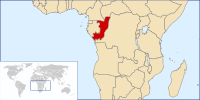Scientists say study proves chimps create termite gathering tools
Wednesday, March 4, 2009

Image: Vardion.
Researchers say that a study of chimpanzees in the Republic of the Congo in Africa, show that they specifically create and design tools to catch termites living underground. The study was performed in the Nouabale-Ndoki National Park in the Congo in an area known as the Goualougo Triangle. The study was published in the Royal Society journal Biology Letters.
Dr. Crickette Sanz, the leader of the team who filmed the chimps crafting "fishing rod" type tools, says that they have "invented" ways of "improving their termite-fishing technique" by using a stick from a plant called the Marantaceae. They pick off the leaves and then create and place a brush like object on the end. Doing so improved the number of termites they catch, by more than 10 times.
"They then pulled the herb stems through their teeth, which were partially closed, to make the brush and they also attended to the brush by sometimes pulling apart the fibres to make them better at gathering the termites," stated Sanz to the BBC.
Researchers are aware that chimps have used similar methods in the past, but it was not fully known if the tools they used were designed specifically for the task of gathering the insects. Of all the tools the chimps left behind and recovered by Sanz's team, 80% were custom made by their owners. Sanz says the new study has determined that their methods have since evolved, proving previous hypotheses.
"Our results indicate that chimpanzees have a mental template of the tool form, which is employed in crafting the tool prior to use and refining it during use," Sanz said.
Sanz also says that because of Africa's vastness, much of it is still unstudied leaving him to suggest other species of chimps and apes use complex tools to gather food.
"Just as we are learning about these exciting new complex tool behaviours, the chimps that are showing us these behaviours are under danger from logging, poaching and Ebola," added Sanz. The triangle is a host to a variety of endangered or threatened animals including gorillas and elephants.
Sources
- Rebecca Morelle. "Chimps craft ultimate fishing rod" — BBC News, March 4, 2009
- "Upping the ant-e: Clever chimps boost termite catch" — Agence France-Presse, March 4, 2009

